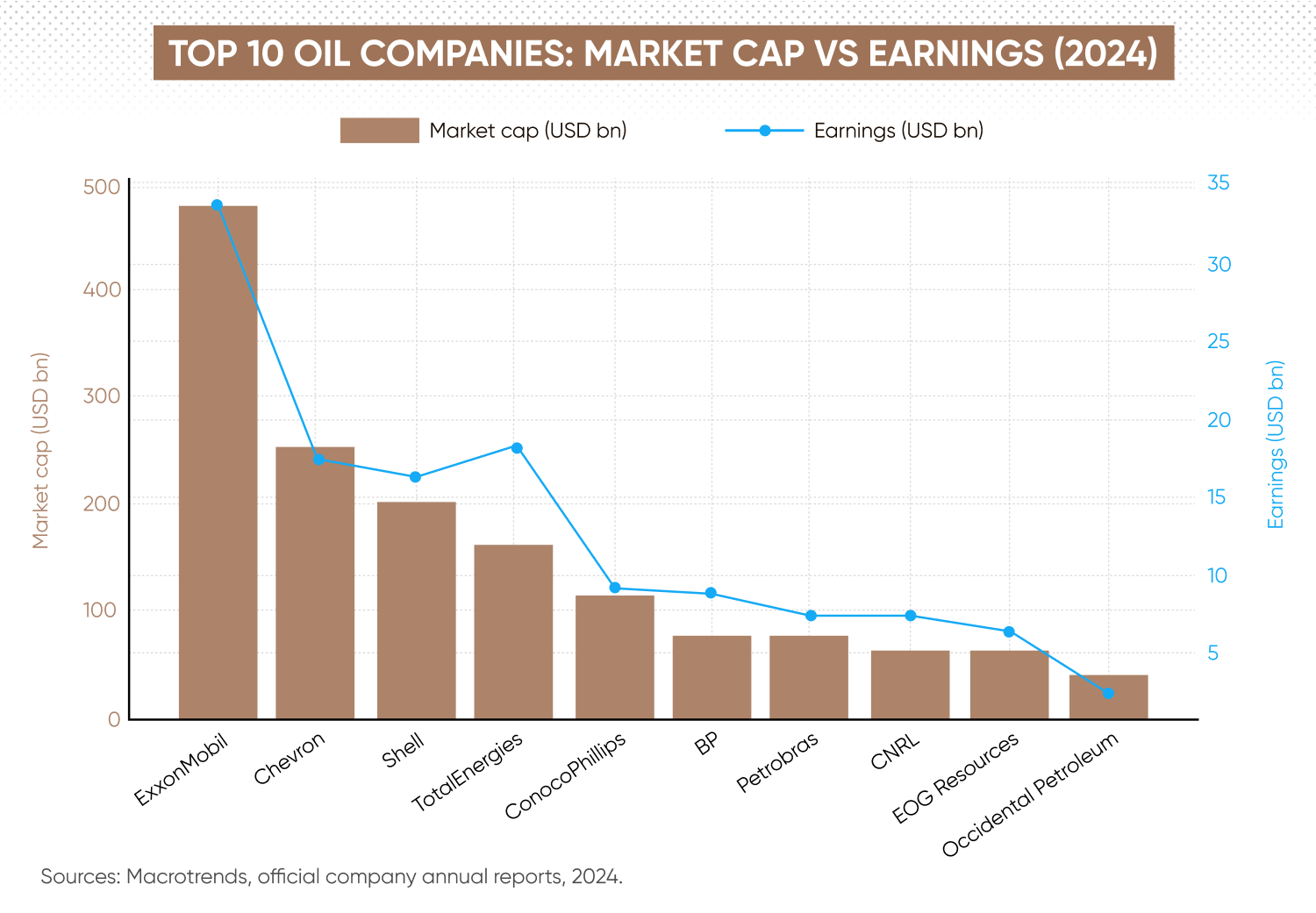Top 10 biggest oil companies in the world
Discover the 10 biggest oil companies in the world for traders, why they are so liquid, and the market strategies to consider.
This guide explores the world’s top 10 biggest oil companies by market cap – focusing on the tradable names that show strong liquidity, frequent price movement and global relevance. Whether you're scanning for volatility or seeking insight into sector drivers, read on to find out more about the oil stocks worth knowing.
Why oil stocks attract traders
Oil stocks attract traders based on their interplay with global supply and demand. That alone gives them outsized influence – and considerable trading potential. But there's more to the story, with liquidity, volatility and geopolitical market drivers also key factors in explaining the popularity of these oil shares in CFD trading.
Liquidity and volatility of oil companies
Large-cap oil stocks are among the most liquid on the market, with millions of shares changing hands daily. This generally makes for tighter spreads and faster execution – which many believe makes for ideal short-term trading.
For example, ExxonMobil and Chevron are consistently among the most actively traded energy stocks on US exchanges, while European giants like Shell and BP regularly respond to regional policy shifts or changes in commodity prices. This high turnover can allow traders to enter and exit positions quickly, often with minimal slippage.
Volatility is another key draw. Oil markets are often famously sensitive to geopolitical events. Sanctions on Russian exports, conflict in the Middle East, hurricane damage to Gulf of Mexico rigs, or unexpected changes to the US Strategic Petroleum Reserve (SPR) can all trigger significant price movement.
One recent example: in April 2024, crude oil prices spiked nearly 6% in a single session following reports of escalating tensions in the Strait of Hormuz, a critical shipping lane for global oil flows. Stocks like Occidental and EOG, with strong exposure to US shale, rallied in tandem.
Key market drivers for oil companies
While supply and demand fundamentals drive the broader crude oil market, individual stocks react to many other triggers:
-
Earnings reports: a quarterly beat or miss can drive short-term momentum. In Q2 2025, TotalEnergies jumped over 4% intraday after announcing stronger-than-expected liquefied natural gas (LNG) revenues.
-
Mergers and acquisitions: consolidation in the sector often sparks rallies. Chevron’s Permian Basin deal in May 2025 saw its shares gain 8% over two days.
-
Dividend changes: companies like Petrobras are known for unexpected dividend announcements that move the stock significantly.
-
Policy news: EU carbon taxes, US drilling regulations or OPEC production targets can all have sector-wide impact.
Meanwhile, the global push for energy security – especially after disruptions caused by the Russia-Ukraine conflict – has reinforced the strategic importance of oil and natural gas. LNG exports, particularly to Europe and Asia, remain a focal point, boosting shares in companies like Shell, TotalEnergies and ConocoPhillips.
What is the biggest oil company in the world?
When it comes to the biggest oil company in the world, one producer stands out – Saudi Aramco tops the list by both market capitalisation and production volume. Although it's not publicly listed outside Saudi Arabia, it remains a vital benchmark for the sector.
Market cap and production-based rankings
Saudi Aramco holds the top spot in both market capitalisation and production scale, with a valuation well above $1.8 trillion and output exceeding 10 million barrels per day. While not listed outside Saudi Arabia, it remains a crucial benchmark for the rest of the sector.
Relevance for trading
When it comes to tradable oil stocks, ExxonMobil (XOM) and Chevron (CVX) dominate the global scene. Both are US-listed, extremely liquid, and consistently among the most actively traded energy names on Capital.com.
Top 10 biggest oil companies for traders
The biggest oil stocks to invest in or trade aren’t just the largest by market cap – they’re also among the most liquid and widely watched by traders. These companies move with headlines, earnings, and geopolitical events, creating potential opportunities for short-term trading.
While these are the biggest oil companies globally, their size doesn’t mean stability. Sharp price swings are common and can put capital at risk. Market cap figures are shown in US dollars (converted at the prevailing exchange rate if relevant) and are accurate as of July 1, 2025, but may change over time.
1. ExxonMobil
-
Market cap: ~$480 billion
-
Regions: USA, Guyana, Permian Basin, offshore Brazil
-
Ticker: XOM
-
Why consider trading it? High volume, consistent volatility, and massive exposure to upstream oil and gas.
2. Chevron
-
Market cap: ~$251 billion
-
Regions: US (Permian), Australia, Kazakhstan, Nigeria
-
Ticker: CVX
-
Why consider trading it? Chevron offers geopolitical risk exposure and high beta to oil prices.
3. Shell
-
Market cap: ~$207 billion
-
Regions: Europe, Gulf of Mexico, Nigeria, Asia-Pacific
-
Ticker: SHEL
-
Why consider trading it? As one of Europe’s biggest energy plays, Shell is influenced by EU policy, natural gas flows, and FX fluctuations.
4. TotalEnergies
-
Market cap: ~$163 billion
-
Regions: France, Africa, Middle East, Americas
-
Ticker: TTE
-
Why consider trading it? French major with heavy LNG exposure and a strong dividend story.
Trade TotalEnergies
5. ConocoPhillips
-
Market cap: ~$114 billion
-
Regions: US (Alaska, Lower 48), Qatar, Malaysia
-
Ticker: COP
-
Why consider trading it? One of the most nimble E&Ps. Plays LNG trends hard.
6. BP
-
Market cap: ~$79.8 billion
-
Regions: UK, US, Azerbaijan, Egypt
-
Ticker: BP
-
Why consider trading it? Heavily affected by political risk and headline-driven swings. Recent asset sales and refinery spin-offs add catalysts.
7. Petrobras
-
Market cap: ~$77.7 billion
-
Regions: Brazil
-
Ticker: PBR
-
Why consider trading it? Political drama, dividend surprises, and Brazil’s forex volatility have interested traders previously.
8. Canadian Natural Resources
-
Market cap: ~$65.8 billion
-
Regions: Canada
-
Ticker: CNQ
-
Why consider trading it? A top oil sands name. Volatile with high correlation to WTI/Brent spreads and North American export policy.
Trade Canadian Natural Resources
9. EOG Resources
-
Market cap: ~$65.2 billion
-
Regions: USA
-
Ticker: EOG
-
Why consider trading it? A pure-play shale operator with a focus on profitability and efficient drilling. Has historically shown strong momentum during crude spikes.
10. Occidental Petroleum
-
Market cap: ~$41.3 billion
-
Regions: USA, Middle East, Colombia
-
Ticker: OXY
-
Why consider trading it? Warren Buffett’s stake made headlines, but OXY is also a favourite for its shale exposure.
Past performance is not a reliable indicator of future results.

Potential oil stocks to watch
Beyond the top 10 oil stocks by market cap, several other oil stocks stand out for their recent volatility and trading volume. These are often driven by news events, earnings surprises or geopolitical developments, offering short-term movement for confident traders.
High-volatility examples
Oil stocks tend to react sharply to headlines – especially those involving supply disruptions, corporate actions or regulatory shifts. This can make them useful vehicles for short-term positioning.
Recent market movers
-
Chevron rallied 8% in May 2025 after confirming a multi-billion-dollar Permian acquisition.
-
Petrobras surged 14% on the reinstatement of a larger-than-expected dividend.
-
ExxonMobil climbed after topping Q1 earnings forecasts and revising up LNG output targets.
Other names to monitor
Outside the majors, smaller-cap names with concentrated regional exposure or speculative interest – such as Marathon Petroleum, Devon Energy or Apache Corp – can also see sharp moves in response to macro shifts.
YPF stock
YPF stock has gained momentum following a US court ruling on June 30, 2025, ordering Argentina to transfer its 51% stake in the company to a custody account. This decision, part of a $16.1bn judgment over the 2012 nationalisation, has heightened interest in the YPF stock price, making it a focal point for news-driven traders.
Want to track the key events that shape oil markets? Browse our oil price news.
Past performance is not a reliable indicator of future results.
Oil trading strategies to consider
Oil stocks often react quickly to news. CFD traders can use various strategies – ranging from technical to event-driven – to attempt to capture short-term price moves.
-
Breakout trading: this strategy aims to catch sharp moves when a stock breaks above or below a defined support or resistance level. For example, if Chevron (CVX) pushes through a three-month high with increased volume, some traders might enter a long position to ride the momentum.
-
Pairs trading: useful in range-bound markets, this involves going long one stock and short another in the same sector. For instance, if Shell appears stronger than BP based on relative strength or earnings outlook, traders might buy Shell and short BP to hedge broader oil-sector exposure.
-
Event trading: some traders position ahead of key market events like OPEC meetings, earnings releases or geopolitical news. For example, Petrobras shares often move sharply following Brazilian political announcements or dividend changes.
-
Trend following: this approach uses moving averages or indicators like MACD to identify upward or downward momentum. If a stock like EOG Resources crosses above its 50-day moving average and stays above it, trend-followers may take a long view until the trend shifts.
Read more on technical analysis and risk management
FAQs
What is the biggest oil company in the world?
Saudi Aramco is the largest oil company globally by both market capitalisation and production volume, though it's not publicly listed outside Saudi Arabia. Among tradable stocks, ExxonMobil holds the leading position based on size and liquidity.
Are oil stocks a good investment?
Oil stocks can offer high volatility, strong liquidity and react to macro events, making them attractive to traders looking for short-term price movement. However, they also carry greater risk due to external factors such as policy shifts, geopolitical tensions and commodity price swings.
What are the best oil stocks for short-term trading?
While there is no one ‘best oil stock’, ExxonMobil (XOM) stands out for size and consistent news flow. Chevron (CVX) often reacts to production updates. Petrobras (PBR) shows volatility and FX exposure, while Occidental (OXY) is known for its speculative momentum and trading volume.
How can I trade oil stock CFDs on Capital.com?
To trade oil stock CFDs, you can open a live account or practise with a demo account first. Capital.com offers 0.024-second execution (all Capital.com servers, 2025), transparent pricing and trading tools like technical indicators and price alerts – available on both desktop and mobile platforms.